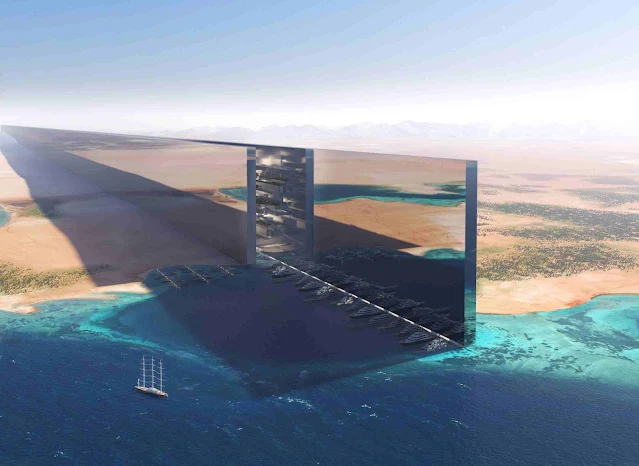Climate scientist warns Neom project may alter local weather patterns
Concerns rise over environmental impact of Saudi Arabia’s Neom as experts cite possible changes in wind and storm activity.
 |
| The mirrored skyscraper is designed to extend into the Red Sea. (c) Neom |
A prominent climate scientist advising Saudi Arabia’s ambitious Neom project has raised fresh concerns that the futuristic development could have unintended consequences on the local climate. The Neom project, spearheaded by Crown Prince Mohammed bin Salman and backed by a $500 billion investment plan, is under renewed scrutiny for both its feasibility and environmental risks.
Donald Wuebbles, a respected atmospheric scientist and former lead author for the United Nations’ Intergovernmental Panel on Climate Change (IPCC), told the Financial Times that Neom’s massive scale and architectural layout may disrupt local weather patterns, potentially intensifying desert wind and sandstorms, and even altering rainfall.
Wuebbles serves as a paid member of Neom’s environmental advisory committee and has reportedly expressed these concerns multiple times. According to him, the shape and scope of Neom’s linear city, known as The Line, as well as its artificial ski slopes and man-made islands, could significantly modify regional weather systems. These effects, he argues, have not been sufficiently studied by the developers.
“Part of my concern was, what impact is The Line and those projects going to have on the local environment?” said Wuebbles. “You start affecting the local weather and climate,” he added, citing potential amplification of storms and shifting rain patterns due to architectural disruption of airflow and urban heat effects.
Rising scrutiny amid leadership changes and project delays
These environmental warnings come as Neom faces leadership turnover and a major project review. The recent departure of Neom’s former CEO, Nadhmi al-Nasr, has led to the temporary appointment of Aiman al-Mudaifer as acting chief executive. Under his supervision, the project's scope is being reconsidered, with reports suggesting a slowdown of six to twelve months.
Wuebbles confirmed that Neom’s advisory committee had recently elevated climate concerns as a higher priority in the wake of these leadership changes. However, he noted that much of the scientific data he had requested on potential climate impacts has not been shared with him, even though Neom has commissioned independent academic research on the matter.
A second member of Neom’s advisory committee, who requested anonymity, corroborated Wuebbles’s concerns, especially over possible weather pattern disruptions and the project’s significant use of cement—a major contributor to carbon emissions.
Urban megastructures and their climatic footprint
The core design of The Line—a narrow, mirrored skyscraper extending up to 500 meters high and initially planned to run for 170 kilometers—raises fundamental questions about how such structures interact with their surrounding environments. Research from institutions like Princeton has shown that urban heat islands can intensify storm activity, altering natural wind patterns and increasing precipitation over built-up areas.
In desert environments like Saudi Arabia’s Tabuk Province, where Neom is being built, such changes could exacerbate sandstorm frequency or reroute seasonal rainfall, leading to unpredictable consequences for ecosystems and communities nearby.
“These are not trivial effects,” said Wuebbles. “They could have serious consequences for biodiversity and weather resilience, especially if they’re not modeled and mitigated properly in the planning stages.”
Environmental policies under review as key staff exit
Sustainability has long been a public pillar of Neom’s development goals. In a statement, Neom claimed it is “a responsible development company” and that it aims to reduce environmental impact compared to traditional construction, especially through its choice of building materials.
Yet internal developments suggest that environmental leadership within Neom may be in flux. Richard Bush, Neom’s chief environment officer, who personally guided committee members on aerial tours of construction zones last year, is reportedly set to leave the project by the end of May. His departure further clouds the future of Neom’s environmental steering committee, whose continuity is now being reconsidered as part of the larger restructuring.
One other member of the steering committee is Usha Rao-Monari, a former adviser to the Blackstone Infrastructure Group and non-executive director at Fortescue, the Australian mining conglomerate. She has declined to comment on the situation, according to a source close to her.
Financial strain adds to project headwinds
Neom’s environmental uncertainty is further complicated by financial constraints. Falling oil prices and reduced foreign investment have made it increasingly difficult for the Saudi government to fully fund the $500 billion development on schedule. Additionally, the sprawling vision for Neom—which includes high-tech transport systems, zero-carbon cities, and artificial islands—has been criticized as overly ambitious.
Wuebbles acknowledged the technological aspirations of the project, stating, “They’re trying to do something like a moonshot: nothing like this has been done before, and there’s so much that could be learned.” But he also emphasized that without a comprehensive environmental strategy, even the most advanced cities risk long-term sustainability failures.
Global comparisons and regulatory gaps
Internationally, other nations have started mandating stricter environmental measures for large infrastructure projects. Norway, for instance, requires two to four hours of backup battery power for telecoms infrastructure, while Australia offers grants to support up to 12 hours of battery life for remote network sites. These steps aim to ensure that vital services remain functional in adverse weather conditions or power outages—an issue that parallels Neom’s own challenge of building resilience into extreme desert environments.
Neom’s reliance on traditional construction techniques—such as combustion engine vehicles and emissions-heavy materials like concrete—has drawn criticism from some environmentalists who say the project contradicts its sustainability rhetoric.
Wuebbles concluded by stressing the need for transparency and scientific rigor: “What’s missing is open engagement with the scientific community. If Neom is to serve as a blueprint for future sustainable cities, it needs to lead not just in technology, but in accountability and ecological foresight.”
As the megaproject navigates environmental scrutiny, leadership changes, and financial uncertainty, the world will be watching whether Neom can deliver on its promise of a greener, smarter city—or whether it will become a cautionary tale in climate-conscious urban development.
